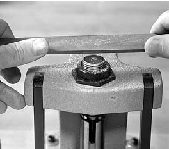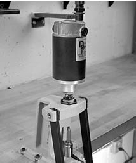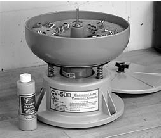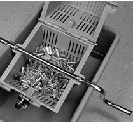Case Trimmers
With the tremendous stresses placed on them, cases tend to stretch or lengthen during firing, and again in the resizing process. Unless this stretching is held to within the chamber’s dimensions, the case neck may reach a point where it is being jammed tightly between the chamber walls and the bullet. This can raise pressures to a dangerous level, giving rise to a hazardous situation. In addition to the safety issue, crimps are strongly influenced by case length. If cases vary in length, some will be given a tighter crimp than others. This, in turn, will have an adverse effect on ignition, accuracy, and velocity. By simply keeping your cases trimmed to a particular length, all these potential pitfalls can be avoided.
In the reloading data section of this manual, there are two lengths listed for each case. The dimensions listed beside the case drawing is the maximum length. The other dimension, listed in the Test Components heading, is the Trim-to length. Normally, this is approximately .010″ shorter than the maximum length for rifle cases. In some pistol or straight-wall cases, this will be only .005″ shorter than the maximum length. When trimming a batch of cases, set your trimmer (if it is adjustable) to the listed trim-to length.
There are several different types of trimmers on the market, running in complexity and price from simple trim dies to motorized trimmers like the Gracey and Dillon models. There are advantages and disadvantages to each of the different styles, so we’ll discuss each in turn.
On the most basic end of the scale, we have trim dies. Trim dies are little more than a sizing die, which has been cut off flush with the case mouth when the case is at the top of the ram stroke. Any part of the case mouth that extends past the top of the trim die is removed with a few strokes of a file. The top surface of the die is surface hardened, so the file cannot damage the die. After trimming, the case mouth will need to be chamfered and deburred before the case can be loaded. In their favor, trim dies are inexpensive and easy to use.
 |
|
A trim die in use. Any portion of the case mouth extending above the die is removed with the file, bringing it back to its proper dimensions.
|
Being for only one specific cartridge, they lack the versatility of the lathe type trimmers. For handloaders dealing with only one or two cartridges and doing a relatively small amount of shooting, trim dies may be the easiest and most economical method for keeping cases at minimum length. Based on a sizing die, they do have certain disadvantages. Naturally, they are only available for the more popular standard cartridges, and a custom wildcat would require a specially made trim die. Headspace cannot be adjusted without changing the case length, which defeats the purpose of the die. In large chambers, this may also mean working the brass more than would normally be desirable. If any of these problems arise with your particular rifle, one of the other types of trimmers may be called for.
The lathe type trimmers are probably the most commonly seen case trimmers in use today. As the name implies, these trimmers resemble a small lathe. With the case head held firmly in place by a collet, and the mouth centered on the mandrel, the case is fed into a cutter. The trimmers can be adjusted exactly to a specified length, and locked to trim all subsequent cases to this same length. By simply changing the collet and mandrel, and readjusting the stops to control trim length, these units can be used to trim virtually any case. Unlike the trim die, there is no chance for headspace to be affected. When using any type of adjustable trimmer, stop occasionally and confirm that the trim length has not changed.
 |
|
The manually operated lathe-type trimmer is still the most common trim tool in use today.
|
Lathe type trimmers are available from most manufacturers of reloading equipment, in both manual and motorized versions. An additional benefit specific to these trimmers is that they often serve as the base for a variety of other tools used in case preparation work. The trimmers marketed by Forster and L.E. Wilson are good examples. With the addition of a few accessories, this type of trimmer can clean primer pockets, inside neck ream, outside neck turn, and square case heads. For the handloader dealing with a wide variety of cartridges, the lathe type trimmer will likely be the most versatile and cost effective.
The last category would include high volume motorized units such as those marketed by Doyle Gracey, or the Dillon Rapid Trim. These differ in operation, but both are intended for trimming large numbers of cases in a short period of time. The Dillon unit uses a sizing die, similar to the trim dies discussed earlier. Instead of a file, the case is trimmed by a carbide cutter driven by an electric motor mounted above the die. Unlike the file-type trim dies, headspace and trim length can be adjusted independently in the Dillon trimmer. Trimming different cartridges requires different dies. Again, these are limited to the most popular standard calibers. On the other hand, the Gracey trimmer uses no dies at all. With the cutter being driven by an electric motor, cases are hand fed into the trimmer, much in the same manner that pencils are fed into a pencil sharpener. A shell holder (not to be confused with the shell holders used on reloading presses) provides a ledge on which the case shoulder stops, limiting its entry into the trimmer and controlling the trim length. Headspace is unaffected, and the case is not sized in this operation.
 |
|
A motorized trimmer makes it easy to trim large numbers of cases in a hurry. The model shown is a Dillon Rapid Trim 1200B.
|
Both of these units offer an extremely fast method of case trimming, with production rates of 500-1000 cases an hour. Before purchasing a trimmer, take a look at some of the different options available and decide which one best fits your needs. Case trimming is normally one of the more tedious steps in the reloading process, but it must be done. Careful selection of the tools used can make this essential operation much more efficient and cost effective.
Chamfering and Deburring Tools
When cases are trimmed, a sharp edge around the case mouth will be formed. This edge must be removed to reduce “shaving” of the bullet during seating. This is accomplished by cutting a slight bevel on both the inside and outside of the case mouth. Most reloading tool manufacturers make special cutters for this operation. Known as deburring tools, these small hand held cutters will quickly and efficiently remove the sharp edges left by the trimming operation. In practice, the cutting edges of the deburring tool are placed against the case mouth, and the case is deburred with a quick twist. There are mounted units available as well, both manual and motorized. The mounted units are a big help in reducing hand fatigue when a large number of cases must be done, but in general, deburring is a quick and easy operation.
Tumblers and Polishers
Although not absolutely essential, a case tumbler or polisher will help in producing good looking reloaded ammunition. There are several tangible benefits to polishing your cases beyond the obvious improvement in appearance. Case inspection becomes much easier when the brass has been thoroughly cleaned. The life of the sizing die can be greatly extended by removing surface grit from the brass that may otherwise enter the die and scratch the surface of the die’s chamber walls. If only a small number of cases are being processed, they can easily be wiped off with a cleaning rag. When large lots of cases are being done, some form of tumbler is the fastest and most efficient way to handle the task.
There are many different models of case tumblers on the market today, ranging in size from small rock tumblers capable of handling only fifty or so .38 Special cases at a time, to large vibratory tumblers capable of cleaning nearly 600 .30-06 cases at once. Today, dry media tumblers are the most frequently encountered, though there are some that use liquid cleaning solutions. A few tumblers can use both. Since the dry media tumblers are by far the most common, our discussion will center on them.
 |
|
Many handloaders tumble their cases to provide clean, professional looking loaded ammunition.
|
Most dry tumblers utilize ground nut shells or corn cob, usually impregnated with a fine jeweler’s rouge or polishing compound. In operation, the tumbling motion or vibration causes the cases to be polished as the media passes over and around them. The time required to clean a batch of cases will vary, depending on the degree to which they are tarnished, the aggressiveness of the polishing compound, and the action of the tumbler itself. This may be as little as 15-30 minutes, or as long as several hours to achieve the desired results. There are presently several polishing compounds made specifically for case cleaning. While it would seem to be a logical choice, do not use Brasso or any other type of brass cleaning solutions that contain ammonia. Strong concentrations of ammonia will chemically attack the case and weaken it, leading to a potentially dangerous situation. With any make of tumbler, follow the manufacturer’s instructions for best results.
 |
|
A media separator such as this one from Dillon Precision, makes separating polishing media from cases fast and easy.
|
We recommend tumbling fired cases before they are resized. We have had good results using a two phase polishing process, tumbling cases thoroughly before resizing, and again after resizing. This second tumbling requires just a few minutes to remove the resizing lubricant, and is best accomplished with a fine-grained nut shell media. This second tumbling can, of course, be omitted and the resizing lube wiped off with a clean rag. If the cases have been tumbled after being sized, some polishing media may be jammed into the flash hole. Some medias are worse about this than others (large grained ground nut shell being particularly bad), but tumbled cases should always be inspected for this condition before repriming. If media is found in the flash hole, it can easily be dislodged with a straightened paper clip or dental pick.
Regardless of the method used, handloaders should never tumble loaded ammunition. Doing so may cause a deterioration of the powder’s deterrent coating, or, in extreme cases, may damage the powder itself. Either situation would alter the burning rate, possibly raising pressures to dangerous levels.
Shell Holders
A shell holder is a single part or unit of parts that provide a method of securing a case to the press during reloading operations. In most reloading presses, the shell holder will be a single, machined piece which snaps into the ram. An entire range of sizes is available, to cover all of the various head sizes and configurations. There are also universal shell holders available, such as those marketed by Quinetics Corp., which utilize a sectioned collet. Shell holder design is fairly well standardized among the various reloading tool manufacturers, and most will interchange from one brand to another without difficulty. Despite this, we feel that it is generally best to use the same make of shell holder as the press that it’s used in. This will help to reduce the possibility of misalignment, dimensional differences, or any other potential trouble spots.
There are some presses that use alternative shell holders, such as the Bonanza Co-ax press, and the now discontinued RCBS Big Max. Both of these use a shell holder that is built into the press, and is more or less universal. The Co-ax press uses a pair of plates that are cut to conform to the size of most case heads, and is reversible to accommodate different size cases.
Progressive presses present something of a different situation, due to their complexity and specialized features. Most progressive presses use a shell plate in lieu of the more conventional shell holders used by singe stage presses. Because of the tremendous differences in design between progressive presses, shell plates must be matched to both the case, and the particular press being used. For example, when loading .45 ACP cartridges on a Dillon progressive, different shell plates are required for each of their RL550B, XL650 and RL1050 machines. This situation holds true for all other cartridges as well. There is no universal interchangeability between shell plates of different brands of presses.
